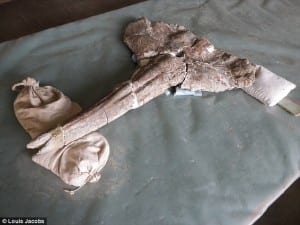Ancient whale swam hundreds of miles up African river and left behind clues about geology and climate change

The Los Angeles Times covered the research of SMU paleontologist Louis L. Jacobs, a professor in the Roy M. Huffington Department of Earth Sciences of SMU’s Dedman College of Humanities and Sciences.
Jacobs is co-author of a study published in the Proceedings of the National Academy of Sciences.
Findings of the research provide the first constraint on the start of uplift of East African terrain from near sea level.
Uplift associated with the Great Rift Valley of East Africa and the environmental changes it produced have puzzled scientists for decades because the timing and starting elevation have been poorly identified.
Jacobs and his colleagues tapped a fossil from the most precisely dated beaked whale in the world — and the only stranded whale ever found so far inland on the African continent — to pinpoint for the first time a date when East Africa’s mysterious elevation began.
The 17 million-year-old fossil is from the beaked Ziphiidae whale family. It was discovered 740 kilometers inland at a elevation of 620 meters in modern Kenya’s harsh desert region.


The article published March 16, 2015.
EXCERPT:
By Geoffrey Mohan
Los Angeles Times
A 22-foot beaked whale that apparently took a wrong turn up an African river about 17 million years ago may offer clues to the climate-change forces that shaped human evolution.Lost for more than 30 years, the fossilized beak with part of the jaw bone helps determine that the East African Plateau probably began rising no earlier than 17 million years ago, according to a study published online Monday in the journal Proceedings of the National Academy of Sciences.
That geologic upheaval in an area known as the cradle of humankind is believed to be responsible for the gradual conversion of dense, humid forests into more sparsely treed grasslands that made upright locomotion on two feet advantageous to evolving human ancestors.
“The whale is telling us all kinds of things,” said study coauthor Louis Jacobs, a paleontologist at Southern Methodist University in Dallas. “It tells us the starting point for all that uplift that changed the climate that led to humans. It’s amazing.”
Jacobs had been searching for the specimen since 1980, when he was head of paleontology at the National Museums of Kenya. He had read about the 1964 find, by James G. Mead of the Smithsonian Institution, in a 1975 research paper.
Every time Jacobs visited Harvard, Washington or Nairobi, he would try to find it.
“It was protected by a plaster jacket, so you couldn’t really see it,” he said. “I suspect nobody knew what it was. It was just kept in the collections there.”
Finally, just before another trip to Kenya in 2011, a collections official at Harvard located the fossil, sheathed in the protective jacket, Jacobs said.
Jacobs had the specimen scanned and analyzed, then contacted Henry Wichura, a structural geologist at the University of Potsdam in Germany, who had been studying plateau region, trying to determine when it started rising. He had found evidence that rivers and lava had flowed east from high points on the plateau at least 13 million years ago.
Follow SMUResearch.com on twitter at @smuresearch.
SMU is a nationally ranked private university in Dallas founded 100 years ago. Today, SMU enrolls nearly 11,000 students who benefit from the academic opportunities and international reach of seven degree-granting schools. For more information see www.smu.edu.
SMU has an uplink facility located on campus for live TV, radio, or online interviews. To speak with an SMU expert or book an SMU guest in the studio, call SMU News & Communications at 214-768-7650.



